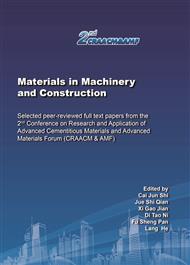[1]
F.V. Ferreira, W. Franceschi, B.R.C. Menezes, et al, Chapter one - synthesis, characterization, and applications of carbon nanotubes, Carbon-Based Nanofillers Their Rubber Nanocompos. 2019: 1-45.
DOI: 10.1016/b978-0-12-813248-7.00001-8
Google Scholar
[2]
K.A. Shah, B.A. Tali, Synthesis of carbon nanotubes by catalytic chemical vapour deposition: a review on carbon sources, catalysts and substrates, Mater. Sci. Semicond. Process. 41 (2016) 67-82.
DOI: 10.1016/j.mssp.2015.08.013
Google Scholar
[3]
S.M. Jafarpour, M. Kini, S.E. Schulz, et al, Effects of catalyst configurations and process conditions on the formation of catalyst nanoparticles and growth of single-walled carbon nanotubes, Microelectron. Eng. 167 (2017) 95-104.
DOI: 10.1016/j.mee.2016.11.007
Google Scholar
[4]
S.P. Chai, S.H.S. Zein, A.R. Mohamed, The effect of catalyst calcination temperature on the diameter of carbon nanotubes synthesized by the decomposition of methane, Carbon. 45 (2007) 1535-1541.
DOI: 10.1016/j.carbon.2007.03.020
Google Scholar
[5]
X. Jiang, X. Chen, C. Ling, et al, High-performance Cu/ZnO catalysts prepared using a three-channel microreactor, Appl. Catal., A. 570 (2019) 192-199.
DOI: 10.1016/j.apcata.2018.11.023
Google Scholar
[6]
Anne-ClaireDupuis, The catalyst in the CCVD of carbon nanotubes—a review, Prog. Mater. Sci. 50 (2005) 929-961.
Google Scholar
[7]
H. Liu, S. Xu, G. Zhou, CO2 hydrogenation to methane over Co/KIT-6 catalyst: effect of reduction temperature, Chem. Eng. J. 351 (2018) 65-73.
DOI: 10.1016/j.cej.2018.06.087
Google Scholar
[8]
Y. Kanda, C. Temma, A. Sawada, et al, Formation of active sites and hydrodesulfurization activity of rhodium phosphide catalyst: effect of reduction temperature and phosphorus loading, Appl. Catal., A. 475 (2014) 410-419.
DOI: 10.1016/j.apcata.2014.01.049
Google Scholar
[9]
X. Ma, K. Cui, W. Hao, et al, Alumina supported molybdenum catalyst for lignin valorization: effect of reduction temperature, Bioresour. Technol. 192 (2015) 17-22.
DOI: 10.1016/j.biortech.2015.05.032
Google Scholar
[10]
C.L. Yao, W.J. Bai, L. Geng, et al, Experimental study on microreactor-based CNTs catalysts: preparation and application, Colloids Surf., A. 583 (2019) 124001.
DOI: 10.1016/j.colsurfa.2019.124001
Google Scholar
[11]
X. Jiang, X.C. Chen, C. Ling, et al, High-performance Cu/ZnO catalysts prepared using a three-channel microreactor, Appl. Catal., A. 570 (2019) 192-199.
DOI: 10.1016/j.apcata.2018.11.023
Google Scholar
[12]
R.L. Vander Wal, T.M. Ticich, V.E. Curtis, Substrate–support interactions in metal-catalyzed carbon nanofiber growth , Carbon. 39 (2001) 2277-2289.
DOI: 10.1016/s0008-6223(01)00047-1
Google Scholar
[13]
S.X. Sun, J.Q. Hu , J. Li, et al, Effect of calcination temperature on synthesis of carbon nanotubes CO2 chemical vapor deposition catalyzed by Ni-Fe catalyst, Mod Chem Ind. 38 (2018) 168-172.
Google Scholar
[14]
V. Jourdain, C. Bichara, Current understanding of the growth of carbon nanotubes in catalytic chemical vapour deposition, Carbon. 58 (2013) 2-39.
DOI: 10.1016/j.carbon.2013.02.046
Google Scholar
[15]
R. Liu, T.C. Xiao, X.L. Wang, et al, Preparation of hierarchical SAPO-34 molecular sieve catalysts with polyethylene glycol as the mesopoer-generating agent and their application for methanol to olefins, Ind. Catal. 12 (2016).
Google Scholar
[16]
S.P. Chai, S. Hussein, S.Z.R. Mohamed, The effect of catalyst calcination temperature on the diameter of carbon nanotubes synthesized by the decomposition of methane , Carbon. 45 (2007) 1535-1541.
DOI: 10.1016/j.carbon.2007.03.020
Google Scholar
[17]
S.L. Wu, C.M. Chen, J.H. Kuo, Synthesis of carbon nanotubes with controllable diameter by chemical vapor deposition of methane using Fe@Al2O3 core-shell nanocomposites, Chem. Eng. Sci. 217 (2020) 115541.
DOI: 10.1016/j.ces.2020.115541
Google Scholar
[18]
C.Emmenegger, J.-M.Bonard, P.Mauron, et al, Synthesis of carbon nanotubes over Fe catalyst on aluminium and suggested growth mechanism, Carbon. 41 (2003) 539-547.
DOI: 10.1016/s0008-6223(02)00362-7
Google Scholar


